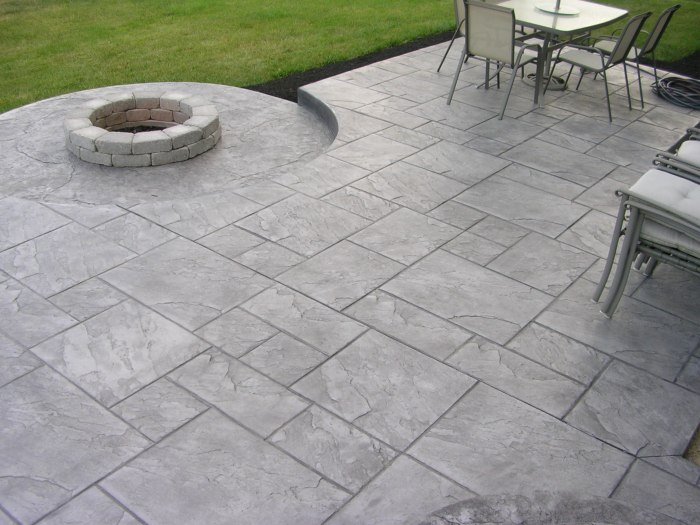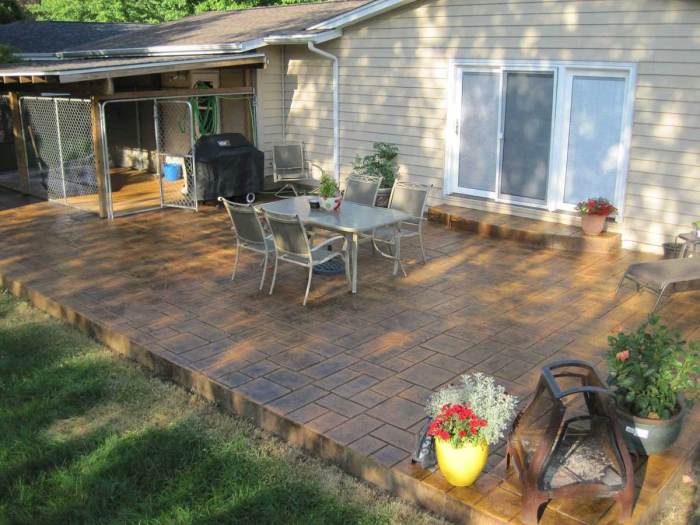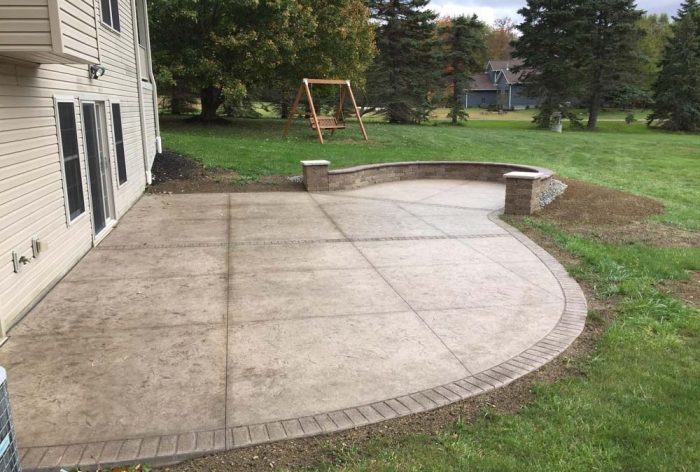Concrete patios offer a durable and versatile foundation for your outdoor living area. With a wide range of finishes available, you can customize your patio to complement your home’s architectural style and personal preferences. This guide will explore the different types of concrete patio finishes, their advantages and disadvantages, and provide inspiring design ideas to help you create the perfect outdoor oasis.
From the classic elegance of stamped concrete to the modern sophistication of polished concrete, each finish offers unique characteristics and aesthetic appeal. Whether you’re looking for a natural stone look, a vibrant stained finish, or a smooth, glossy surface, there’s a concrete patio finish that will suit your vision.
Concrete Patio Finishes
Concrete patios offer a durable and versatile surface for outdoor living spaces. When it comes to finishes, there are several options to choose from, each with its unique advantages and characteristics.
Stamped Concrete
Stamped concrete is created by pressing patterns or textures into freshly poured concrete. This technique allows for a wide range of design possibilities, including brick, stone, wood, and even custom designs. Stamped concrete is durable and requires minimal maintenance, making it a popular choice for high-traffic areas.
Stained Concrete
Stained concrete involves applying a chemical stain to the surface of the concrete. This process alters the color of the concrete, creating a unique and decorative finish. Stained concrete is less durable than stamped concrete but offers a more subtle and sophisticated look.
Polished Concrete
Polished concrete is achieved by grinding and polishing the surface of the concrete to create a smooth, reflective finish. This process exposes the aggregate in the concrete, resulting in a durable and visually appealing surface. Polished concrete is ideal for modern and industrial-style patios.
Stamped Concrete Patio Designs
Stamped concrete patios offer a creative and durable way to enhance your outdoor living space. This innovative technique mimics the look of natural materials like stone and wood, providing a sophisticated and stylish finish.
With a wide range of patterns and colors to choose from, you can customize your stamped concrete patio to match your home’s aesthetic and create a truly unique outdoor oasis.
Stone-Inspired Designs
Stone-inspired stamped concrete designs bring the beauty and elegance of natural stone to your patio. From classic cobblestone to intricate slate, these patterns create a timeless and sophisticated look.
- Cobblestone: Irregularly shaped stones create a charming and rustic appeal.
- Slate: Smooth, layered slabs of slate offer a sleek and modern touch.
- Ashlar: Rectangular stones arranged in a uniform pattern provide a classic and elegant look.
Wood-Inspired Designs
Wood-inspired stamped concrete designs capture the warmth and natural beauty of wood. These patterns replicate the grain and texture of various wood species, offering a durable and low-maintenance alternative to traditional wood decking.
- Cedar: A classic choice that mimics the rich reddish-brown tones of cedarwood.
- Redwood: A deep, reddish-brown hue that evokes the warmth and elegance of redwood.
- Teak: A golden-brown color with a distinctive grain pattern that adds a touch of exotic flair.
Staining Techniques for Concrete Patios
Staining is an effective method for enhancing the appearance of concrete patios, adding depth, character, and style. There are several staining techniques to choose from, each offering unique results.
Acid Staining
Acid staining is a chemical process that creates permanent, non-fading color by reacting with the minerals in the concrete. It is applied with a spray bottle or brush and produces a variegated, mottled effect. Acid stains are available in a wide range of colors, allowing for customization.
Water-Based Stains
Water-based stains are acrylic-based and penetrate the concrete’s surface, creating a more uniform color. They are easier to apply than acid stains and are available in a variety of shades. However, they may fade over time.
Dyes
Concrete dyes are semi-transparent and provide a more subtle color change than stains. They are applied with a brush or roller and can be used to create custom colors by mixing different shades. Dyes are not as durable as stains but are less expensive.
Step-by-Step Guide to Staining a Concrete Patio
- Clean the patio thoroughly to remove dirt, debris, and any previous coatings.
- Apply a concrete etching solution to open up the concrete’s pores and prepare it for staining.
- Apply the stain according to the manufacturer’s instructions, using a spray bottle, brush, or roller.
- Allow the stain to penetrate for the recommended time.
- Rinse the patio thoroughly with water to remove excess stain.
- Seal the patio with a concrete sealer to protect the stain and enhance its durability.
Polished Concrete Patio Finishes
Polishing concrete patios involves grinding and polishing the surface to create a smooth, glossy finish. This process enhances the concrete’s durability and reduces maintenance requirements. Polished concrete patios are available in a range of colors and textures, offering aesthetic versatility.
Process of Polishing Concrete Patios
Polishing concrete patios is a multi-step process that requires specialized equipment and expertise. The surface is first ground using diamond-tipped abrasives to remove imperfections and expose the aggregate. Subsequent grinding steps use finer abrasives to create a smooth surface. The final step involves polishing the surface using polishing pads to achieve a glossy finish.
Benefits of Polished Concrete Patios
Polished concrete patios offer several benefits, including:
- Durability: Polished concrete is highly resistant to wear and tear, making it an ideal choice for high-traffic areas.
- Low Maintenance: Polished concrete requires minimal maintenance, such as occasional cleaning and sealing.
- Aesthetic Appeal: Polished concrete patios come in a variety of colors and textures, allowing for customization to match any design style.
- Improved Reflectivity: Polished concrete reflects light, making patios appear brighter and more spacious.
Pictures of Polished Concrete Patios
[Insert images of polished concrete patios in different colors and textures]
Decorative Concrete Patio Borders and Edging
Concrete patios offer a durable and versatile surface for outdoor living spaces. Enhancing their aesthetic appeal, decorative borders and edging can transform a simple patio into a visually captivating focal point. This guide explores creative and functional options for designing borders and edging, incorporating materials like pavers, bricks, and stones to create unique accents.
Paver Borders
Pavers are versatile and durable materials that can create visually appealing borders. They come in a wide range of colors, textures, and shapes, allowing for endless design possibilities. Paver borders can be laid in straight lines, curves, or intricate patterns to complement the overall patio design.
The contrasting colors and textures add depth and character, defining the patio’s perimeter while providing a functional transition to surrounding areas.
- Straight Borders: Classic and straightforward, straight paver borders provide a clean and defined edge. They are suitable for both modern and traditional patio designs.
- Curved Borders: Soft and inviting, curved paver borders create a more organic and flowing look. They can be used to delineate curved seating areas or accentuate architectural features.
- Patterned Borders: Intricate paver patterns add a touch of sophistication and elegance to concrete patios. Herringbone, basketweave, or circular patterns can create eye-catching accents that enhance the overall aesthetic.
Concrete Patio Finishes for Different Styles
Concrete patios can be customized to complement a variety of architectural styles. By selecting the appropriate finish, homeowners can create an outdoor space that seamlessly blends with the overall aesthetic of their property.
Modern Style
Modern concrete patios prioritize clean lines, geometric shapes, and a minimalist approach. Polished concrete finishes, such as those with a high-gloss sheen, create a sleek and contemporary look. Stamped concrete patterns, like large squares or rectangular shapes, add visual interest without compromising the modern aesthetic.
- Polished concrete finish with a high-gloss sheen
- Stamped concrete patterns featuring large squares or rectangular shapes
- Exposed aggregate finishes showcasing the natural beauty of the aggregate
Rustic Style
Rustic concrete patios evoke a sense of warmth and coziness. Stained concrete finishes, in earthy tones like browns and greens, mimic the look of natural stone. Broom-finished concrete, with its rough texture, adds a rustic charm to the outdoor space.
- Stained concrete finishes in earthy tones
- Broom-finished concrete with a rough texture
- Stamped concrete patterns resembling cobblestones or flagstone
Mediterranean Style
Mediterranean concrete patios exude a warm and inviting ambiance. Textured finishes, such as stenciled or hand-troweled concrete, create a unique and visually appealing surface. Decorative concrete borders and edging, featuring intricate designs or colorful tiles, add a touch of elegance.
- Textured finishes, including stenciled or hand-troweled concrete
- Decorative concrete borders and edging with intricate designs or colorful tiles
- Warm color tones, such as terracotta or golden hues
Summary
Concrete patio finishes provide endless possibilities to enhance the beauty and functionality of your outdoor space. By understanding the different types of finishes, their advantages, and design considerations, you can make an informed decision that will complement your home’s aesthetic and lifestyle.
Whether you prefer the timeless appeal of stamped concrete, the vibrant hues of stained concrete, or the sleek elegance of polished concrete, there’s a finish that will transform your concrete patio into an inviting and stylish outdoor living area.



